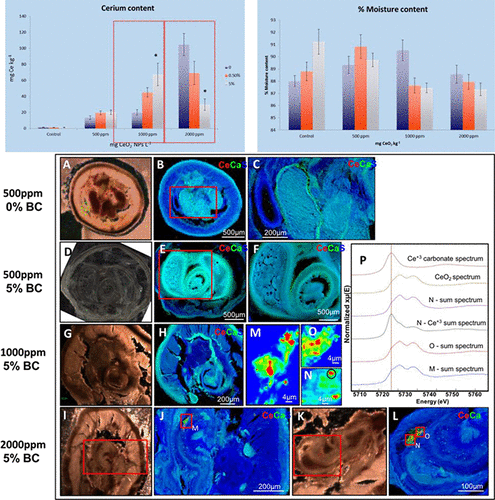当前位置:
X-MOL 学术
›
J. Agric. Food Chem.
›
论文详情
Our official English website, www.x-mol.net, welcomes your
feedback! (Note: you will need to create a separate account there.)
Bioaccumulation of CeO2 Nanoparticles by Earthworms in Biochar-Amended Soil: A Synchrotron Microspectroscopy Study
Journal of Agricultural and Food Chemistry ( IF 5.7 ) Pub Date : 2017-12-28 00:00:00 , DOI: 10.1021/acs.jafc.7b04612 Alia D. Servin , Hiram Castillo-Michel 1 , Jose A. Hernandez-Viezcas 2 , Wout De Nolf 1 , Roberto De La Torre-Roche , Luca Pagano 3, 4 , Joseph Pignatello , Minori Uchimiya 5 , Jorge Gardea-Torresdey 2 , Jason C. White
Journal of Agricultural and Food Chemistry ( IF 5.7 ) Pub Date : 2017-12-28 00:00:00 , DOI: 10.1021/acs.jafc.7b04612 Alia D. Servin , Hiram Castillo-Michel 1 , Jose A. Hernandez-Viezcas 2 , Wout De Nolf 1 , Roberto De La Torre-Roche , Luca Pagano 3, 4 , Joseph Pignatello , Minori Uchimiya 5 , Jorge Gardea-Torresdey 2 , Jason C. White
Affiliation

|
The interactions of nanoparticles (NPs) with biochar and soil components may substantially influence NP availability and toxicity to biota. In the present study, earthworms (Eisenia fetida) were exposed for 28 days to a residential or agricultural soil amended with 0–2000 mg of CeO2 NP/kg and with biochar (produced by the pyrolysis of pecan shells at 350 and 600 °C) at various application rates [0–5% (w/w)]. After 28 days, earthworms were depurated and analyzed for Ce content, moisture content, and lipid peroxidation. The results showed minimal toxicity to the worms; however, biochar (350 or 600 °C) was the dominant factor, accounting for 94 and 84% of the variance for the moisture content and lipid peroxidation, respectively, in the exposed earthworms. For both soils with 1000 mg of CeO2/kg at 600 °C, biochar significantly decreased the accumulation of Ce in the worm tissues. Amendment with 350 °C biochar had mixed responses on Ce uptake. Analysis by micro X-ray fluorescence (μ-XRF) and micro X-ray absorption near edge structure (μ-XANES) was used to evaluate Ce localization, speciation, and persistence in CeO2- and biochar-exposed earthworms after depuration for 12, 48, and 72 h. Earthworms from the 500 mg of CeO2/kg and 0% biochar treatments eliminated most Ce after a 48 h depuration period. However, in the same treatment and with 5% BC-600 (biochar pyrolysis temperature of 600 °C), ingested biochar fragments (∼50 μm) with Ce adsorbed to the surfaces were retained in the gut after 72 h. Additionally, Ce remained in earthworms from the 2000 mg of CeO2/kg and 5% biochar treatments after depuration for 48 h. Analysis by μ-XANES showed that, within the earthworm tissues, Ce remained predominantly as Ce4+O2, with only few regions (2–3 μm2) where it was found in the reduced form (Ce3+). The present findings highlight that soil and biochar properties have a significant influence in the internalization of CeO2 NPs in earthworms; such interactions need to be considered when estimating NP fate and effects in the environment.
中文翻译:

char在生物炭改良土壤中对CeO 2纳米颗粒的生物富集:同步加速器显微研究
纳米颗粒(NPs)与生物炭和土壤成分的相互作用可能会大大影响NP的利用率和对生物群的毒性。在本研究中,earth(Eisenia fetida)在居住或农业土壤中暴露28天,该土壤经0-2000 mg CeO 2改性。NP / kg和含生物炭(在350和600°C的山核桃壳热解过程中产生的)[0–5%(w / w)]。28天后,将earth净化,并分析铈含量,水分含量和脂质过氧化作用。结果表明对蠕虫的毒性极小。然而,生物炭(350或600°C)是主要因素,分别占裸露earth中水分含量和脂质过氧化作用差异的94%和84%。对于两种含有1000 mg CeO 2的土壤/ kg在600°C,生物炭显着降低了蠕虫组织中Ce的积累。350°C生物炭的修正对铈的吸收有不同的反应。利用X射线荧光(μ-XRF)和近边缘结构的X射线吸收(μ-XANES)进行分析,以评估Ce净化12次后,CeO 2和暴露于生物炭中的Ce中Ce的定位,形态和持久性,48和72小时。在净化48小时后,来自500 mg CeO 2 / kg和0%生物炭处理的worm消除了大多数Ce。然而,在相同的处理中,在5%BC-600(生物炭热解温度为600°C)下,摄入的生物炭碎片(〜50μm)被Ce吸附在表面72小时后被保留在肠道中。此外,从2000毫克的CeO 2中,铈残留在earth中/ kg净化48小时后,进行5%生物炭处理。分析μ-XANES表明,蚯蚓组织内,CE仍主要以Ce 4+ ö 2,只有少数地区(2-3微米2,其中它被还原形式(铈找到)3+)。目前的发现表明,土壤和生物炭特性对in中CeO 2 NPs的内在化具有重要影响。在估算环境中的NP命运和影响时,需要考虑这种相互作用。
更新日期:2017-12-28
中文翻译:

char在生物炭改良土壤中对CeO 2纳米颗粒的生物富集:同步加速器显微研究
纳米颗粒(NPs)与生物炭和土壤成分的相互作用可能会大大影响NP的利用率和对生物群的毒性。在本研究中,earth(Eisenia fetida)在居住或农业土壤中暴露28天,该土壤经0-2000 mg CeO 2改性。NP / kg和含生物炭(在350和600°C的山核桃壳热解过程中产生的)[0–5%(w / w)]。28天后,将earth净化,并分析铈含量,水分含量和脂质过氧化作用。结果表明对蠕虫的毒性极小。然而,生物炭(350或600°C)是主要因素,分别占裸露earth中水分含量和脂质过氧化作用差异的94%和84%。对于两种含有1000 mg CeO 2的土壤/ kg在600°C,生物炭显着降低了蠕虫组织中Ce的积累。350°C生物炭的修正对铈的吸收有不同的反应。利用X射线荧光(μ-XRF)和近边缘结构的X射线吸收(μ-XANES)进行分析,以评估Ce净化12次后,CeO 2和暴露于生物炭中的Ce中Ce的定位,形态和持久性,48和72小时。在净化48小时后,来自500 mg CeO 2 / kg和0%生物炭处理的worm消除了大多数Ce。然而,在相同的处理中,在5%BC-600(生物炭热解温度为600°C)下,摄入的生物炭碎片(〜50μm)被Ce吸附在表面72小时后被保留在肠道中。此外,从2000毫克的CeO 2中,铈残留在earth中/ kg净化48小时后,进行5%生物炭处理。分析μ-XANES表明,蚯蚓组织内,CE仍主要以Ce 4+ ö 2,只有少数地区(2-3微米2,其中它被还原形式(铈找到)3+)。目前的发现表明,土壤和生物炭特性对in中CeO 2 NPs的内在化具有重要影响。在估算环境中的NP命运和影响时,需要考虑这种相互作用。











































 京公网安备 11010802027423号
京公网安备 11010802027423号